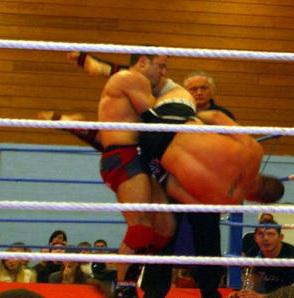
SEO and MMA blog founder Drew Griffiths
" data-orig-size="294,298" sizes="(max-width: 294px) 100vw, 294px" data-image-title="SEO_Drew" data-image-caption="" aperture="aperture" />Article by Drew Griffiths (BSc, MSc)
Like all contact sports, MMA comes with a relatively high risk of injury. It’s unlikely that you’ll compete in MMA for a year for example, without sustaining some type of injury in training or a fight.
There is some research to suggest that MMA is less dangerous than boxing.
Researchers at the U of A’s Glen Sather Sports Medicine Clinic reviewed a decade’s worth of data from medical examinations following mixed martial arts and boxing matches and found that MMA fighters face a slightly higher risk of minor injuries. Boxers, however, are more likely to experience serious harm from concussions and other head trauma, loss of consciousness, eye injuries, smashed noses and broken bones.
https://www.eurekalert.org/news-releases/639963
The best way to reduce the risk of injury, is to find a ‘good’ and ‘sensible’ gym to train at. Gyms that focus on technique, fitness and a good attitude, are much less likely to see injured fighters during training sessions, than gyms which are more ‘gung ho’ with hard sparring, and less strict with fighters general behavior.
Do you wear wraps under MMA gloves?
When fighting, yes – you should wear hand wraps under MMA gloves. The wrists should also be wrapped. Many fighters damage there hands even when they have a professional wrap their hands, so the damage would likely but much worse if fighters were to wear just gloves, and no wraps.
Does MMA training build muscle?
Whether or not MMA training will build muscle, depends a lot on your baseline or starting level of muscle and how much exercise you are doing. If you are in your 20s and have a completely sedentary job and lifestyle, then doing MMA, particularly grappling, will likely result in your body adapting and building muscle, as well as strength. However, you will begin to level off and plateau relatively quickly in terms of muscle gains if you are not eating adequate calories and protein. If you want to add serious amounts of muscle, you should also look to add some resistance training to your weekly exercise program/programme.
How to become an MMA referee?
There are various ways to become an MMA referee, but a typical route would include:
- Gaining experience as an MMA fighter
- Watching MMA on a regular basis
- Completing an MMA referee course such as Marc Goddard’s
- Gaining experience as a referee on a voluntary basis at local shows
Are MMA gloves good for punching bags?
MMA gloves, meant for professional fights, are not ideal for hitting a heavy bag as they are only 4oz and don’t provide much protection for the wrist and knuckles – especially without hand wraps. For hitting heavy bags, it’s best to start with gloves that are 12oz and use hand wraps. If you are looking to condition and harden your fists, you may wish to use thinner gloves, but there’s definitely a risk of injury with 4oz MMA gloves.
Can you do MMA with braces?
You can train in MMA with braces, as long as you have a custom fitted mouthguard. You’ll typically also need to speak to your dentist first to make sure that it’s safe.
Do MMA fighters take creatine?
A large percentage of MMA fighters use creatine. Creatine is one of the most effective sports supplements for power and strength, according to research. When fighters are cutting weight however, many stop taking creatine due to the high levels of dehydration. For more information on taking creatine for MMA and BJJ, see our article.
Do MMA fighters train everyday?
Most professional MMA fighters will train 5 or 6 days per week. Some fighters will train twice on some days, with for example wrestling training in the morning and Muay Thai in the evening of the same day. Other days could involve a morning BJJ session and strength & conditioning in the evening or afternoon. There is a very real risk of overtraining and injury when training so frequently. It’s important that pro fighters have coaches and physiologists to monitor levels of blood lactate, inflammation and stress hormones such as cortisol. Resting heart rate and heart rate recovery is also an important metric to monitor to mitigate the risk of overtraining and burnout.
How to become an MMA fighter?
The best way to become an MMA fighter is to build a good base of fitness, power and flexibility. There are many fighters who train for many years, but are limited by poor flexibility and relatively low levels of explosive power and cardiovascular fitness. Find a good local gym, ideally one that acts as a feeder to local and major MMA shows. Train diligently for several years, compete in grappling competitions and then compete in a local MMA event. From there, build up a record and you can enhance your chances of getting on a big show like the UFC. Bear in mind that MMA is poorly paid, unless you’re a top 10 fighter for your weight division in the world.
How do MMA fighters cut weight?
Cutting weight is very dangerous and requires professional supervision. MMA fighters will reduce carbohydrate intake and water-load to make weight.
Principles & factors regarding weight cutting include:
– 1 gram of carbs, stores an additional 3 grams of water, so carbs need to be reduced
– Sodium/salt makes the body retain water (so don’t have any)
– Drinking lots of water, according to Martin Rooney, makes the body trigger hormones, which in turn, cause the body to excrete more water than normal.
So by drinking 2 gallons, and tapering it down to no water at all, the body will lose more water weight.
– Ensure you have a complete rehydration plan for after the weigh-in. This can include cool baths with salts and glycerol.
For more information on weight cutting, please see our full article here.

